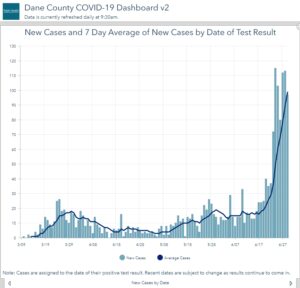A: Even if your local or state public health department hasn’t come out and said so, a sharp increase in COVID-19 in your local area is cause for major concern and deserves a speedy response from you – and hopefully, also your local public health department! Time to cut back your nonessential activities and double-down (or quintuple down, why not?) on your SMART strategies to protect yourself and your community.
When we think about how to evaluate the risk of any given situation, the first question we are asking is, how much disease is circulating in your community?
The answer to this question drives the likelihood that you’ll run into an infected person out there in the world, no matter what activity you’re doing and no matter how you’re doing it. If there are zero cases, then there is zero chance you’ll come into contact with an infected person! If there are a lot of cases, there’s a much higher chance of that happening. So community trends are super important in terms of evaluating how risky your activities are.
In addition, when we see a rapid uptick in the number of cases (or positivity rate, if you like) over a few days, there’s the added concern about pre-symptomatic people. Super nerdy girl extra credit: make sure you’re checking out the scale on the vertical axis–is it changing? If whoever made the chart has to make it taller to accommodate the new cases, YIKES.
Most people who are being tested are symptomatic in most US settings. So if you see a sharp rise in the positive tests for your area, you can think of that as a sharp rise in symptomatic cases–which also means there are an unknown number of other people, walking around somewhere in your community, who don’t even know they are sick yet. They could be spreading COVID-19 to their family members, roommates, coworkers, and drinking buddies today, which means that each of them can lead to even more people who will be testing positive next week. You just cannot tell at this point in a trend whether it’s about to peak or if it’s going to continue growing. (Hint: without policy intervention it will probably keep growing. Public health nerds know all too well that relying on individual, one-off behavioral decisions is a bad way to get things done.)
So a sharp increase like this one, shown for the past week in Dane County, Wisconsin, should be taken into account when you are deciding whether whatever you planned to do this weekend is worth the risk, and the steps you take to protect yourself and your community if you decide it is worth it. If it’s helpful, you might think of it like this: how will I feel about this activity in two weeks if it turns out I get sick while I do it?
To reduce the risks to you and your community, remember the SMART guidelines:
S: SPACE. Keep your distance! 6 ft or more is best.
M: MASK. Keep it on!
A: AIR. Outside is better.
R: RESTRICTED. Keep your social bubble small and stable!
T: TIME. Keep your interactions short!
And the more of these you can implement at the same time, the more layered your protection will be.

Resource to find your county’s current risk status based on population-normalized case counts and recent trends


